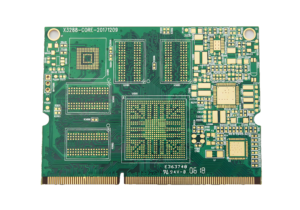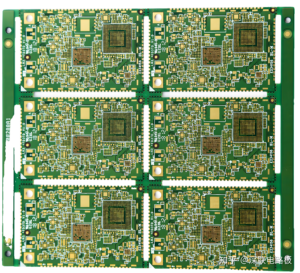HDI PCBs
Your Partner for High-Quality HDI PCBs
Specializing in both Rigid HDI and Rigid-Flex HDI, we offer advanced capabilities including:
- i+N+i (i≥2) HDI & Any Layer HDI
- Blind & Buried Vias, Stacked & Staggered Vias
- Conductive & Non-Conductive Via Plugging
- Ultra-Fine Line/Space: Minimum 1.5/1.5 mil
- Advanced Features: Back Drill, Backplane, Embedded Devices, IC Substrate
Key Design Considerations for HDI PCBs
Designing High-Density Interconnect (HDI) PCBs requires attention to specific factors to ensure optimal performance and reliability. Here are the key considerations:
Each Layer Interconnect (ELIC):
ELIC technology is essential in modern devices like smartphones, reducing the need for mechanical holes and allowing for tighter spacing within the circuit board.Track Uniformity and Minimum Line Width:
Maintaining uniform track widths and adhering to minimum line widths are critical to prevent short circuits and disconnections, ensuring a reliable design.Component Layout:
Precise component placement is crucial in HDI technology. Proper layout ensures that mounting, soldering, and maintenance are feasible, contributing to the overall success of the circuit board.Distribution of Blind and Buried Vias:
Avoid asymmetrical stacking designs, as they can create unnecessary stress and lead to warping of the circuit board. Proper via distribution helps maintain board integrity.Routing Alignments for Signal Integrity:
HDI PCB fabrication allows for smaller routing widths, but these must be carefully designed to maintain signal integrity. This involves using the shortest possible routing paths, consistent path impedance, adequate grounding layers, and proper isolation of digital, analog, and power signals.
By addressing these design considerations, you can maximize the performance, reliability, and longevity of your HDI PCBs, ensuring they meet the demands of today’s advanced electronic devices.
Request Your Free Quote Today!
Understanding HDI PCBs
HDI PCB, or High-Density Interconnect PCB, is a cutting-edge circuit board designed to maximize connectivity and component density while minimizing board size. If you’re familiar with HDI PCBs, you understand their importance in the PCB industry.
Unlike traditional PCBs, which might seem limited in complexity and functionality, HDI PCBs push the boundaries of design by using advanced manufacturing techniques and materials. These boards incorporate multiple layers of conductive traces and vias in a compact space, allowing for more components and intricate circuitry on a single board.
HDI PCBs are crucial in advanced electronic devices like smartphones, tablets, medical equipment, and high-performance computing systems. These devices demand high functionality, miniaturization, and top-tier performance, all within a small form factor—making HDI PCBs a key component in their design.
As one of the fastest-growing technologies in the PCB and PCBA industry, HDI PCBs utilize micro-blind and buried-hole technology to achieve higher-density line distribution. If you recognize this, you’re already ahead in understanding the latest advancements in PCB technology.
Unlock the Technical Advantages of HDI PCBs
HDI circuit boards offer numerous technical benefits that can enhance your PCB design. Here’s how you can leverage these advantages:
Enhanced Design Flexibility:
HDI PCBs provide greater design flexibility compared to traditional SMT boards. Their high component density enables faster signal processing and more efficient designs.Compact Footprint:
Advanced HDI manufacturing techniques allow for more connections on the same board with fewer layers, optimizing space and reducing the overall size of the PCB.
Unmatched Reliability:
HDI circuit boards are ideal for dense, complex packages with high pin counts and low pitch, ensuring reliable performance even in the most demanding applications.Perfect for Complex Designs:
HDI PCBs are the go-to choice for intricate packages that require high-density interconnects, making them perfect for advanced, compact devices.Meeting the Demand for Miniaturization:
As the need for smaller, lighter PCBs grows, HDI boards deliver high functionality in a reduced form factor, making them ideal for modern, space-constrained applications.Superior Signal Integrity:
The advanced features of HDI PCBs improve signal integrity and electrical performance, ensuring your designs meet the highest standards.
Material Requirements for Automotive HDI PCBs
Automotive HDI printed circuit boards are essential in critical systems like advanced driver assistance systems (ADAS), infotainment, and other safety-related applications. The materials used in these PCBs must meet stringent requirements to ensure optimal performance and reliability in demanding automotive environments. Here are the key characteristics to consider:
High Thermal Conductivity:
Automotive electronics generate significant heat, making efficient heat dissipation crucial. HDI PCB materials should possess high thermal conductivity to quickly dissipate heat and maintain stable performance.
High Tg (Glass Transition Temperature):
HDI PCBs used in automotive applications must withstand high temperatures. A high Tg rating ensures the board remains stable and reliable under the extreme temperature conditions common in automotive environments.Low CTE (Coefficient of Thermal Expansion):
Automotive electronics operate across a wide range of temperatures, so the PCB material’s CTE should closely match that of other system components. This minimizes thermal stress and prevents potential damage from expansion and contraction.High Reliability and Durability:
Automotive environments are harsh, with exposure to vibrations, temperature fluctuations, and other challenging conditions. HDI PCBs must be made from durable, reliable materials to ensure long-term performance and safety.
Common materials for automotive HDI PCBs include high-temperature FR-4, polyimide, and ceramic, each chosen for their ability to meet these demanding requirements. By selecting the right materials, you can ensure your automotive HDI boards deliver exceptional performance and reliability in even the most challenging conditions.
Essential Criteria for Automotive HDI PCB Manufacturers
HDI (High-Density Interconnect) PCBs are integral to automotive applications like LIDAR, radar, communication systems, ECUs, audio systems, and telematics. Their reliability, low signal loss, and compact design make them a top choice in the automotive industry. When choosing an HDI PCB manufacturer for automotive use, consider these essential criteria:
Quality Certifications:
Look for certifications such as ISO 9001:2015 and ISO/TS 16949:2016, which guarantee adherence to the highest industry standards.Automotive Industry Experience:
Opt for a manufacturer with a proven track record in the automotive sector, familiar with specific industry requirements and standards.
Advanced Materials and Processes:
Ensure the manufacturer uses high-temperature, high-reliability materials and employs stringent quality control measures.Expert Design Capabilities:
Choose a manufacturer with deep expertise in HDI PCB design, particularly in addressing space constraints, thermal management, and signal integrity.Comprehensive Testing and Validation:
The manufacturer should adhere to industry standards like AEC-Q100 and AEC-Q200, ensuring that their PCBs meet all necessary specifications.Strong Supply Chain Management:
A robust supply chain is critical for sourcing high-quality materials and ensuring timely delivery.
Choosing a manufacturer that excels in these areas is crucial for producing high-quality, reliable automotive HDI PCBs that meet the rigorous demands of the industry.
What Sets High-Density PCBs Apart from Standard PCBs?
HDI PCBs are built using advanced technology that packs a high density of components into a small area. In contrast, standard PCBs have a lower component density and are designed for simpler applications.
HDI PCBs offer a higher level of complexity, featuring micro vias and buried holes that connect different layers of the board, enabling a more compact and efficient design. Standard PCBs lack these features, resulting in a less dense and larger board.
Manufacturing HDI PCBs involves multiple lamination cycles, laser drilling, and intricate plating techniques, making it far more complex than the basic lamination process used for standard PCBs.
Due to their advanced technology and complex manufacturing process, HDI PCBs are generally more expensive than standard PCBs, especially when designing any-layer PCBs. This is an important consideration in your design process.
HDI PCBs are essential for advanced applications like smartphones, tablets, and other compact devices that require high functionality in limited space. Standard PCBs, on the other hand, are typically used in simpler household electronics and appliances.
Thanks to finer lines and higher layer counts, HDI PCBs are much smaller and lighter than standard PCBs, making them ideal for modern, miniaturized devices.
HDI PCBs are characterized by high-density features such as micro vias, finer traces, high pad density, and thinner dielectric layers. These features are not found in traditional multi-layer PCBs, which only use through holes.
The precision needed for buried via plugging in HDI PCBs is much higher than in standard PCBs. Poorly executed via plugging can lead to significant quality issues, such as uneven board surfaces, non-uniform dielectric thickness, and compromised pad integrity.
HDI PCBs often use materials like polyimide or polyamide-imide instead of the traditional FR4 found in standard PCBs. They may also include copper foils with higher electroplating thicknesses for superior electrical performance.
While HDI PCBs offer superior performance, functionality, and compact size, they do come at a higher cost compared to standard PCBs. However, for applications that demand cutting-edge technology, the investment in HDI PCBs is well worth it.
Reliability Testing for Automotive HDI PCB Materials
Automotive HDI printed circuit boards are chosen for their exceptional reliability and durability, essential qualities in the demanding environment of modern vehicles. To ensure these standards are met, manufacturers perform a series of rigorous tests during the production process. Here’s a breakdown of the key reliability tests:
This critical test exposes the PCB material to rapid temperature fluctuations between extreme hot and cold environments. It simulates the thermal stress the PCB will experience in real-world automotive applications, ensuring it can withstand these conditions without failure.
In this test, the PCB material is subjected to high humidity levels to assess its resistance to moisture and corrosion. This is crucial for ensuring the long-term durability of the PCB in various environmental conditions.
Mechanical tests are designed to evaluate the physical strength and durability of the HDI PCB material. These include bend tests, vibration tests, and shock tests, all of which help determine the board’s ability to endure the rigors of automotive use.
CAF testing measures the insulation resistance between two electrical conductors on the PCB. By exposing the board to chemicals like sulfur dioxide, nitrogen dioxide, hydrogen chloride, and ozone, this test assesses the board’s long-term performance and resistance to chemical aging in harsh environments.
This test is a key part of the quality assurance process, evaluating the board’s ability to withstand prolonged exposure to extreme temperatures. It’s particularly important for judging the durability and integrity of the solder mask under harsh conditions.
Why Choose LEAPPCB as Your HDI PCBs Partner?
Unmatched Capabilities
LEAPPCB specializes in providing a comprehensive range of rigid PCB solutions, accommodating various materials, layer counts, copper thicknesses, surface finishes, and technologies. Whether you require a straightforward one-layer PCB or a complex 100-layer HDI PCB with intricate vias and fine lines, we have the expertise to fulfill all your needs.
Competitive Pricing
We offer competitive pricing with flexible options tailored to your requirements. Share your technical specifications with us, and we will promptly provide you with a detailed quotation.
Superior Quality
Quality is at the heart of everything we do at LEAPPCB. Our commitment to delivering high-quality rigid PCBs is unwavering, driven by a zero-defect mindset and a culture of continuous improvement. Our production processes adhere to stringent quality management standards, including ISO9001, ISO13485, and TS16949.
Exceptional Customer Service
At LEAPPCB, we believe that open communication and collaboration are the keys to a successful partnership. We treat our customers as partners, aligning our goals with yours to ensure your success. We prioritize your needs and requests, delivering on our commitments every time.
Fast and Reliable Delivery
We are known for our reliability in meeting delivery deadlines. LEAPPCB offers fast turnaround times and expedited options to ensure your projects stay on track. Our adherence to delivery commitments is a testament to our dedication to your success.
Choose LEAPPCB for your rigid PCB needs and experience unparalleled service, quality, and expertise. Contact us today to discuss your project requirements!
Get Your Free Instant Quote Today!
Leap Electronic is your trusted partner and one-stop shop for PCB fabrication, component sourcing, PCB assembly, and electronic manufacturing. With over 16 years of expertise, we proudly serve over 1000 customers worldwide, delivering top-quality PCBs at competitive prices. Our ISO9001:2015 certification and UL listing ensure that all our products meet the highest industry standards. Every PCB is 100% E-tested and inspected using AOI and X-RAY, guaranteeing unparalleled reliability and performance.
Don’t wait – get an instant quote from our sales team today and experience the Leap Electronic difference. We’ll handle the rest!
Everything You Need to Know About HDI PCBs
- HDI (High-Density Interconnect) PCBs are advanced circuit boards with densely packed circuits, multiple layers, and microvias less than 0.15mm. These features allow for high-performance, compact designs.
- Smaller and Lighter: HDI PCBs enable compact designs, ideal for modern, portable electronics.
- Enhanced Performance: They support higher electronic performance and efficiency standards.
- Improved EMI, RFI, and Thermal Management: HDI circuits offer superior resistance to electromagnetic interference, radio frequency interference, and improved thermal conductivity.
- Higher Cost: Due to the small drill sizes and advanced technology, HDI PCBs are more expensive than standard PCBs.
- Longer Lead Times: The complex manufacturing process of HDI PCBs can result in longer production times.
The cost of HDI PCBs varies depending on factors like layer count, via structure, surface finishes, and copper thickness. For an accurate quote, contact our sales team.
- Minimize Process Complexity: Choose the right through-hole types.
- Optimize Component Use: Apply HDI technology selectively.
- Reduce Stress and EMI: Space components effectively.
- Enhance Signal Integrity: Carefully route alignments.
- Cost-Effective Stack-Up: Choose a stack-up that minimizes material costs.
One of the main challenges in HDI PCB manufacturing is buried hole plugging. Improper plugging can lead to significant quality issues like uneven board edges and pad defects.
The fabrication process involves multiple steps, including core board fabrication, laser drilling, metallization, pattern transfer, and final inspection. This complex process ensures the high quality and reliability of HDI PCBs.
- 1+N+1, 2+N+2, 3+N+3, 4+N+4 HDI Structures
- i+N+i Structure
- Any Layer Connection
- An HDI stack-up includes signal, power, and ground layers. Proper stack-up design is critical for signal integrity and overall PCB performance.
HDI vias are created using laser drilling, making them smaller and more precise than traditional mechanically drilled vias.
- Equipment: Ensure the supplier uses state-of-the-art equipment for HDI production.
- Skilled Personnel: Look for experienced engineers specializing in laser drilling, laminating, and process control.
- Production Control: The supplier should have a complete in-house production system with strict quality control.
- Density and Precision: HDI PCBs feature smaller drill sizes and tighter trace widths.
- Design Complexity: HDI designs are more intricate, with extensive interconnections.
- Cost and Equipment: HDI PCBs are more expensive and require advanced manufacturing equipment.
- Assembly Challenges: The use of smaller components makes HDI PCB assembly more challenging.
